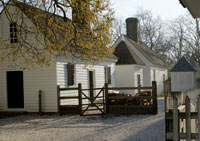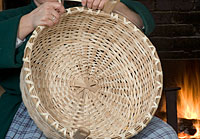Page content
Basketmaker
- Baskets necessary for rural family life
- Families made rather than purchased baskets
- White oak preferred material
- Entire family learned the trade
Families made their own baskets
Woven white oak baskets were as useful to colonial Virginians as they were simple, beautiful, and strong. Basketmaking was a domestic activity rather than a business, as families needed baskets of all sizes and shapes for personal family use, and most families made their own baskets – which lasted many years.
American white oak was preferred construction material
Today demonstrated at the Wythe House, basketmaking requires an ax, a few wedges, a pocket knife, and a supply of small trees. White oak is preferred because it is the only tree in Virginia that will split thin and remain flexible enough to weave. Baskets can be made also from grasses or vines, but 18th-century baskets were used for work and not as accessories and oak made the most durable ones. In England, where basketmaking is a profession, willow osier is grown specifically for the trade. Willow did not occur naturally in 18th-century Virginia and Virginians were too busy growing cash crops to be bothered with growing willow. Instead, they used the abundant white oak trees to make strong baskets.
Weaving and plaiting required nimble fingers
To start a basket, a basketmaker cut down a small white oak tree about five to ten inches in diameter and with six feet of usable trunk. The log was split down its length in half and then continually split by half until the tree was reduced to a bundle of flexible weaving splits. The wood was not soaked, but allowed to dry for a day or two to shrink and stabilize. The basketmaker determined the shape and size of a basket. Weaving required more nimbleness than strength, and both men and women made baskets and taught the children as soon as they were old enough to learn.


